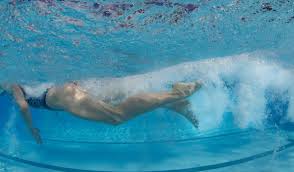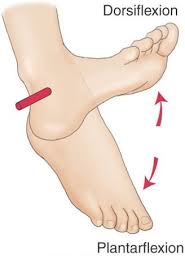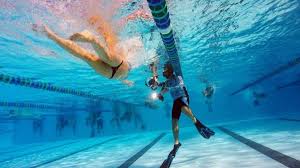Every Freestyler has heard the words, “Point your toes when you kick!”
But, why?
In our next series, we investigate what muscles are required to have a powerful flutter kick, how much ankle flexibility a swimmer needs, and how much a running background affects a swimmer’s ability to efficiently kick?
So let’s get back to the business.
When a swimmer is kicking Freestyle—they should point their toes. And I don’t mean point their toes backwards towards their shin (that’s referred to as Dorsiflexion), but actively point their toes away from their body (in Plantarflexion). See image below.

The muscles required to move the foot into plantar flexion are: Gastrocnemius, Soleus, Flexor hallucis longus, Flexor digitorum longus, Tibialis posterior, Plantaris, and the Achilles Tendon.
Those are all fancy words for the muscles and tendons that make up the majority of your calf, shin, heal, and foot regions.
When a swimmer plantar flexes their foot, the muscles in the calf are shorten to bring the heal back towards the body and the toes extend away. Also, the Achilles tendon is shortened and the Flexor muscles (hallucis and digitorum longus) are stretched.

But, What’s the Advantage of Kicking in a Plantar Flexed State?
1.) Reduction in drag
2.) Larger surface area
3.) Generate more propulsion
When a swimmer kicks with their feet in a plantar flexed position, it creates a larger surface area on the tops of the feet. The more surface area the feet have, the more propulsion you can generate. Also, a reduction in drag is shown by having the toes flexed, as opposed to the toes pointing towards the bottom of the pool (or perpendicular to the body).
Think of plantar flexion as being similar to using a fin. Everybody kicks faster with fins, but why?

A fin basically amplifies a plantar flexed position. It creates a larger surface area of the foot with A LOT more flexibility, plus it points your toes for you. No one kicks with fins without their foot being in a plantar flexed state.
To work on your plantar flexibility, you need to stretch out your calf muscles and foot/ankle tendons. The more flexibility you can get, the more you can plantar flex your toes. But, what do you do if muscles stretch easy and tendons do not?

If you read this far, here’s the kicker (and props to you ). Do you remember the Flexor muscles we talked about earlier: the Flexor hallucis longus and the Flexor digitorum longus. These are the KEY muscles to stretch in order to gain plantar flexion. Why?
Well these muscles run alongside the shin in front of your leg, but change into tendons above the ankle bone. As tendons they run on top of the foot to each of your five toes. Those tendons are directly responsible to how much plantar flexion you have in your feet. If it’s hard to stretch tendons, but not muscles–why not stretch the muscle? Specifically, the Flexor muscles!

Try this. Take the next week and foam roll your shins. Do everything else the same and tell me whether your plantar flexibility has gotten better. I can almost guarantee it might.
Can’t wait for more insight, [CLICK HERE] to read Part II!
Until next time,
Abbie Fish

10 Responses
Like the Ballerina pic explanation of what to do 👍👊thank you
Thank you!